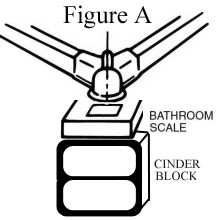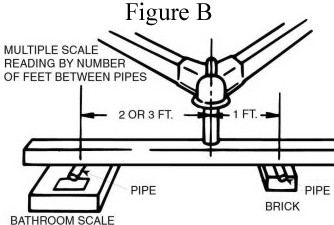Tips And Info
Please Share This Page. Thank You!
Getting to know the terms and components of a trailer
The weight capacities of the tow vehicle, the trailer hitch, ballmount, ball, and safety chains must not be exceeded by the gross trailer weight (GTW). The towing system will only be as strong as the weakest piece.
Gross Trailer Weight (GTW) - the weight of the loaded trailer. To determine GTW, weigh the loaded trailer on a vehicle scale.
Tongue Weight (TW) - the downward pressure placed on the ball by the coupler. On smaller trailers the TW can be measured using a bathroom scale and a box. On a level surface, place the coupler of the loaded trailer on the scale at normal towing height (Figure A). For heavier tongue weights, use the method diagrammed below (Figure B) or use a tongue weight scale.
Trailer Loading:
The way you load the trailer can determine how easy you can tow it. While loading, keep in mind that the tongue weight should be 10% to 15% of the overall trailer weight. One of the main causes of trailer sway is not having a large enough percentage of trailer tongue weight compared to gross trailer weight. To help prevent the trailer from swaying back and forth, a few things can be done. Try placing heavier cargo in the front of the trailer, ahead of the trailer's axle. Also center the cargo left-to-right and use tie-downs to keep the load from sliding.
Trailer Sway can also lead to a loss of vehicle control. When starting out with a new load on a trailer, make sure it will not sway by gradually increasing your speed in intervals until highway speed is reached. If the trailer does begin to sway, try adjusting the cargo and equipment accordingly and then repeat the test. If repositioning the load and equipment did not help reduce the sway, a sway control or a weight distribution system with sway control may be needed.
The way you load the trailer can determine how easy you can tow it. While loading, keep in mind that the tongue weight should be 10% to 15% of the overall trailer weight. One of the main causes of trailer sway is not having a large enough percentage of trailer tongue weight compared to gross trailer weight. To help prevent the trailer from swaying back and forth, a few things can be done. Try placing heavier cargo in the front of the trailer, ahead of the trailer's axle. Also center the cargo left-to-right and use tie-downs to keep the load from sliding.
Trailer Sway can also lead to a loss of vehicle control. When starting out with a new load on a trailer, make sure it will not sway by gradually increasing your speed in intervals until highway speed is reached. If the trailer does begin to sway, try adjusting the cargo and equipment accordingly and then repeat the test. If repositioning the load and equipment did not help reduce the sway, a sway control or a weight distribution system with sway control may be needed.
Driving:
The addition of a trailer adds weight and length to the tow vehicle. More weight means more time to speed up and more importantly, slow down. Overall handling is also affected. When towing, allow for extra time when switching lanes, stopping and passing other vehicles. To assist in slowing down, trailer brakes are a very good option. The extra length can also cause problems on turns. Because the trailer does not follow the exact path as the vehicle on turns, remember to swing out wider when traveling around bends and corners.
To conserve fuel when towing, travel at moderate speeds. Faster speeds increase wind resistance, reduce gas mileage, and place added strain on the vehicle and trailer. When traveling over large hills or down gravel roads, use a lower gear to ease transmission and engine operation. Shifting out of overdrive and into a lower gear may also improve vehicle gas mileage.
Be extra cautious of potholes and other large bumps. Riding over one can damage the tow vehicle, trailer hitch and/or trailer. When pulling a trailer take your time and be careful.
If for some reason (a gust of wind, a downgrade, a pass by a larger vehicle, etc.) the trailer does begin to sway, the driver needs to assess the situation to determine the proper course of action. Here is a list of Do's and Don'ts to think about.
Do's - Good Towing Practice
Don'ts - NOT Good Towing Practice
The addition of a trailer adds weight and length to the tow vehicle. More weight means more time to speed up and more importantly, slow down. Overall handling is also affected. When towing, allow for extra time when switching lanes, stopping and passing other vehicles. To assist in slowing down, trailer brakes are a very good option. The extra length can also cause problems on turns. Because the trailer does not follow the exact path as the vehicle on turns, remember to swing out wider when traveling around bends and corners.
To conserve fuel when towing, travel at moderate speeds. Faster speeds increase wind resistance, reduce gas mileage, and place added strain on the vehicle and trailer. When traveling over large hills or down gravel roads, use a lower gear to ease transmission and engine operation. Shifting out of overdrive and into a lower gear may also improve vehicle gas mileage.
Be extra cautious of potholes and other large bumps. Riding over one can damage the tow vehicle, trailer hitch and/or trailer. When pulling a trailer take your time and be careful.
If for some reason (a gust of wind, a downgrade, a pass by a larger vehicle, etc.) the trailer does begin to sway, the driver needs to assess the situation to determine the proper course of action. Here is a list of Do's and Don'ts to think about.
Do's - Good Towing Practice
- Gradually reduce speed
- Steady the steering wheel - sudden turns can cause more sway
- Apply only the trailer brakes to help reduce trailer sway
Don'ts - NOT Good Towing Practice
- Do Not slam on the brakes - jackknifing could occur
- Do Not attempt to steer out of a sway situation
- Do Not increase speed - Trailer sway increases in faster speeds
- Do Not tow a trailer that continues to sway
- Look at reloading the trailer or perhaps adding a sway control or a weight distribution system with sway control
trailer towing components
Trailer Hitches:
Trailer Hitches are specific to each vehicle and are rated accordingly. To find out how much your vehicle can tow, see the owner's manual. To find out how much weight the trailer hitch can tow look at the sticker on the hitch. Two ratings will normally appear on the sticker, weight carrying and weight distributing. Weight carrying is towing with a ballmount. Weight distributing is towing with a system that includes spring bars that attach to the trailer to help distribute the load.
Trailer Hitches are specific to each vehicle and are rated accordingly. To find out how much your vehicle can tow, see the owner's manual. To find out how much weight the trailer hitch can tow look at the sticker on the hitch. Two ratings will normally appear on the sticker, weight carrying and weight distributing. Weight carrying is towing with a ballmount. Weight distributing is towing with a system that includes spring bars that attach to the trailer to help distribute the load.
Ball Mounts:
Keep in mind the trailer's gross trailer weight and tongue weight when selecting a ball mount for the trailer hitch. Class III ball mounts are selected not only with gross trailer weight in mind, but also trailer height. The more level the trailer, the easier it is to pull.
Keep in mind the trailer's gross trailer weight and tongue weight when selecting a ball mount for the trailer hitch. Class III ball mounts are selected not only with gross trailer weight in mind, but also trailer height. The more level the trailer, the easier it is to pull.
Hitch Balls:
Always make sure the hitch ball weight rating is greater than the gross trailer weight. As for the hole diameter on the ballmount, it must be less than 1/16" greater than the ball shank diameter. When tightening, always use the lock washer and make sure a portion of the ball shank extends past the bottom of the nut.
Information Needed to get the Correct Ball
Always make sure the hitch ball weight rating is greater than the gross trailer weight. As for the hole diameter on the ballmount, it must be less than 1/16" greater than the ball shank diameter. When tightening, always use the lock washer and make sure a portion of the ball shank extends past the bottom of the nut.
Information Needed to get the Correct Ball
- Gross trailer weight (GTW)
- Hole diameter on the ballmount
- Ballmount platform thickness
- Trailer coupler size
Trailer Wiring:
Always make sure the turn signals, brake lights, tail lights, electric brakes, and breakaway switches are working on the trailer prior to each use. Always be sure to find a good secure ground on the trailer and also on the tow vehicle. If the vehicle still needs to be wired, you can usually get a wiring harnesses for most applications.
Always make sure the turn signals, brake lights, tail lights, electric brakes, and breakaway switches are working on the trailer prior to each use. Always be sure to find a good secure ground on the trailer and also on the tow vehicle. If the vehicle still needs to be wired, you can usually get a wiring harnesses for most applications.
Trailer Couplers:
The inside of the coupler should be clean and slightly lubricated with grease. This will help prevent binding during turning and help any moving parts inside the coupler move smoother.
The inside of the coupler should be clean and slightly lubricated with grease. This will help prevent binding during turning and help any moving parts inside the coupler move smoother.
Safety Chains:
Always connect the trailer's safety chains securely to the trailer hitch or tow vehicle by crossing them underneath the coupler. The safety chains should only be long enough to allow for tight turns. Anything longer may weaken the safety feature of the chains if other connections fail. Also make sure the chains cannot wiggle or bounce free and do not let them drag on the ground.
Always connect the trailer's safety chains securely to the trailer hitch or tow vehicle by crossing them underneath the coupler. The safety chains should only be long enough to allow for tight turns. Anything longer may weaken the safety feature of the chains if other connections fail. Also make sure the chains cannot wiggle or bounce free and do not let them drag on the ground.









